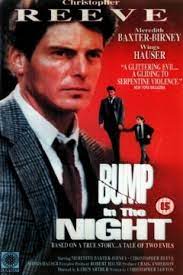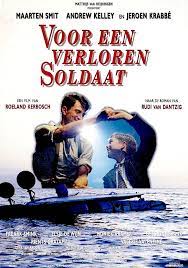Displaying items by tag: Pedophilia and cinema
Bump in the Night

BUMP IN THE NIGHT
US, 1991, 93 minutes, Colour.
Meredith Baxter-Birney, Christopher Reeve, Wings Hauser, Corey Carrier, Richard Bradford, Geraldine Fitzgerald, Shirley Knight, Terrence Mann, Richard Joseph Paul, and to me.
Directed by Karen Arthur.
A strange, unexplained title.
However, this is a 1991 American television movie that is still worth noting.
Basically, it is the story of an abduction of a child, the anxiety of the parents, their participation, with the police, to find the child. The family story is complicated because of the careers of the parents, she, played by Meredith Baxter-Bernie, a successful investigative journalist and Colin writer who has taken to drinking, unreliable, especially with her son, and the father, a successful novelist, played by Wings Hauser.
There is a sympathetic presentation of the police and the investigators, led by Richard Bradford, professional, having to react to the anger of the mother, learns to understand the pressures on the father.
However, the theme that makes this television movie significant, especially in the early 1990s, is that the abductor of the little boy is a paedophile. There had not been many films about paedophiles to this point, Short Eyes with Bruce Davison, a prison film, an example.
What is very telling for this film is that the paedophile is played by Christopher Reeve, a very nuanced performance, taking away from his iconic Superman performances. He plays a literature Prof, colour of the community, discovered to be a paedophile, imprisoned, model prisoner, early release, but in no way cured or rehabilitated. He is in league with the woman associated with the pornographer, she sending him a photo, he paying her $1000, setting up a meeting with the boy on the pretence that the boy was meeting his father.
What is significant for those who want to understand something of a paedophile is the way in which, often subtly, Christopher Reeve plays his role, words spoken, sharing stories, the mentality of the child, touching, moods, the techniques of grooming.
There is an excellent supporting cast, veteran Geraldine Fitzgerald in her last role, Shirley Knight is an alcoholic friend, Terrence Mann as the pornographer.
At the same time the Dutch film, For a Lost, a nonjudgemental portrait of a relationship between an American soldier and a 12-year-old boy, was released, the film that with current understanding of age of consent, legislation about underage sexual relationships, could not be made in the same way today.
- A telemovie of the 1990s? Issues?
- The New York setting, filmed in Pittsburgh, American cities, apartments, police precincts, the streets, atmosphere? The musical score?
- The meaning of the title?
- The initial focus on Jonathan and Martha, ready for school, another drunk, sleep, contact with his father, going to the old lady who was minding his cat, going to the restaurant to wait? School principal, friend of Martha, concern, phone calls, the teacher referring to Martha is drunk, interrogating the little girl? Visiting the old lady with the cats, her information, the later visit and information?
- The tension between husband and wife, her past career as an investigative journalist, success, column? His successes and novelist? The separation? Her drinking? The refusal to admit it? Her irrational behaviour throughout the search, outburst, anger, drinking, the need for a drink? The treatment of people, relegating them? Her attitudes towards Patrick, arguments, anger?
- The introduction to Lawrence Buller, Cheryl the phone call, the photo, the rendezvous, the restaurant, Laurence introducing himself, talking about his father? The film showing something of the psychology and behaviour of the paedophile, the link, the contacts, with child pornography, charm, the mentality of a child and an adult, conversation, trust, sharing stories, the poem, the child trusting? Friendship? The experience of the zoo? Christopher Reeve and his performance, indicating the paedophile, touch, words, persuasive, trust? Techniques of grooming? Knowing how to respond? The rendezvous at the apartment? Pretending about his father to Jonathan? At the apartment, waiting for his father, the photography equipment, Laurence having an answer to everything? Time progressing, Laurence and his moods, angry, aggressive torts Jonathan? Locking the doors? Jonathan, the escape, his ingenuity, going to the attic, hiding, spending the night? Laurence and his frustrations? No food, going out, Jonathan breaking the glass in the window, Laurence noting it? The arguments, cajoling, the ultimate threat of the fire, setting it, getting out of hand?
- Cheryl, the dance company, Nicola 90s and the pornography, getting the photo from the photographer, contacting Lawrence, $1000, the apartment and rendezvous? Nickel ideas, confronting Cheryl, the police, killing Cheryl, searching for the information, going to the apartment, confronting Lawrence, bashing him, Laurence killing him? The police arriving, Laurence killing himself?
- The search for Jonathan, the clues, Martha and her not drinking, moods, aggression, friendship with Katie, sharing the drinking, Katie denying her alcoholism, the sketch of the face, made available, a couple recognising Laurence and telling the police?
- Patrick, his arrival, the tension with Katie, tension with the police, the search?
- Sgt Mooney and his assistant, taking the case seriously, the school, the outbursts, confronting each parent, moving sympathies, memories of Martha and her column? The assistant, actively involved, suggestions? The identification with Laurence Miller, Mooney and his telling of the story of Laurence, University lecturer, pillar of the society, accusations, jail, model prisoner, release? Yet his preying again?
- Martha, the photos, the numberplates, contacting the police, identifying the building? The fire, urging Jonathan down and catching him?
- The resolution, together, going into rehab, possibilities for the future?
- The raising of the issue of paedophilia and dramatising it in 1991? Impact at the time? Later?
For a Lost Soldier/ Vor een verloren soldaat

FOR A LOST SOLDIER/ VOR EEN VERLOREN SOLDAAT
Netherlands, 1992, 92 minutes, Colour.
Marteen Smit, Andrew Kelley, Jeroen Krabbe.
Directed by Roeland Kerbosch.
This film is a memoir of World War II, the German occupation of Holland, the transporting of children from Amsterdam to foster care in the countryside. It opens in 1944, establishes the group of children, their being transported, the adoptive families and welcoming them into their households. The action then moves to 1945, the retreat of the Germans, the arrival of the Americans, liberation. It is the story of Rudi van Dantsig, who wrote his story as a novel, contributed to the screenplay. And it incorporates some of the experiences of the director. Rudi van Dantsig was 11 and 12 at this time, the director was four.
The key theme that put this film into the spotlight was the relationship between an occupying American soldier and the 12-year-old boy. The IMDb describes the film as “touching”. Reviews of the time praise the film for its sensitivity. In fact, it is helpful to look at the variety of comments from the bloggers on the IMDb, most of the comments coming eight years and more after the release of the film. There is praise again of its observation of the situation, the emotions of the characters, especially the boy, praise for the lack of explicit moral judgements about the relationship.
Reviews by critics at the time praise the film.
It has been remarked that the film could not be made like this now.
The chief reason for this is the change of public awareness from the early 1990s to the present, more open discussion about paedophilia, the criminal aspects of paedophilia, legislation about age of consent, prosecution of adults who engage in sexual relationships with underage children, the issue of ability for adult consent by underage children, jail sentences. There has been a strong shift in public awareness and public opinion since the 1990s.
Bypassing, for the moment, the central issue, the film is an interesting and strong presentation of occupied Holland, citizens in Amsterdam and the lack of food, the movement (as in Britain and other countries) of children to the countryside, welcoming families, healthy activity and food, school and church. Church is important in this film, the local pastor, the local teacher, church attendance, reading the Bible. There is work to be done, the city children wanting to escape at first, but becoming involved, the central character here, Jeroen helping with the birth of a calf. On the whole, life in occupied Holland seems quite proper – but suggestions of broader issues with one of the refugees, 15-year-old Jan, with some 15-year-old preoccupations with sex.
With the coming of the Americans, and the sense of liberation, the locals respond to the American presence, a concert with a ventriloquist, a singing group, two of the Americans in drag, then the dancing, jitterbugs, and, before long, the roving eye of the Americans and the response of some of the local girls.
But at the centre of the film is Jeroen, played by Marteen Smit in his sole film performance. He has something of a commanding screen presence simply by being there. The film prepares the audience for the sexual issues by a range of sequences, Jan and Jeroen finding a crashed plane in the waters, stripping off to swim out, some sunbaking, gentle references, at home Jeroen having a bath and getting out of the bath… And, there is the suggestion of Jeroen’s curious attraction to Jan and observing him.
The key American is Walt Cook, played by Andrew Kelley in his only film, who takes a shine immediately to Jeroen, spending time with him, giving him sweets, driving around, going to the wreck, letting him drive the Jeep, talking with, increasing intimacy, the audience sensing the emotional and physical attraction, the gay sensibility, and Walt’s story about his growing up, distance from family, and leaving America, the comfortable response by Jeroen and his wanting to be with Walt. This is grooming.
There is a strong scene of intimacy, in Walt’s room, the two naked, on Walt’s bed, and, something that reviewers and bloggers do not mention, the pained look on Jeroen’s face, some tears, during the penetration sequence. However, Jeroen seems to overcome the pain and becomes ever more devoted to Walt.
As said, public sensibilities watching this film in the early 1990s, were not concentrating on issues of underage sexual relationships (or if this was considered, it was considered emotionally favourably). And, as has been said, in recent years, Walt would have been charged with sexual assault of a minor.
Walt disappears, there are happy memories of a photo, and Jeroen’s mother comes to take him away, and a reminder have how welcoming the foster family, parents and children, was.
But there is a framework to the whole film, Jeroen decades later, a choreographer, rehearsing his troupe, dissatisfied with them, talking about themes of freedom and expression. When this is introduced, Jeroen has memories of the past, meetings his younger self momentarily, then the bulk of the film the flashback story. There is a final meeting between the older and younger, then Jeroen the choreographer having some success with his troupe, and, his assistant finding the photo as well is a photo of Walt’s identity tags. Jeroen has no regrets about the past, only the disappearance of Walt.
A comparison might be made with the 1991 American telemovie, Bump in that Night, with Christopher Reeve playing an English professor who befriends a little boy, enjoying his company – the screenplay helping audiences understand paedophile emotions and attractions.
For a Lost Soldier is readily available on YouTube. As is Bump in the Night.